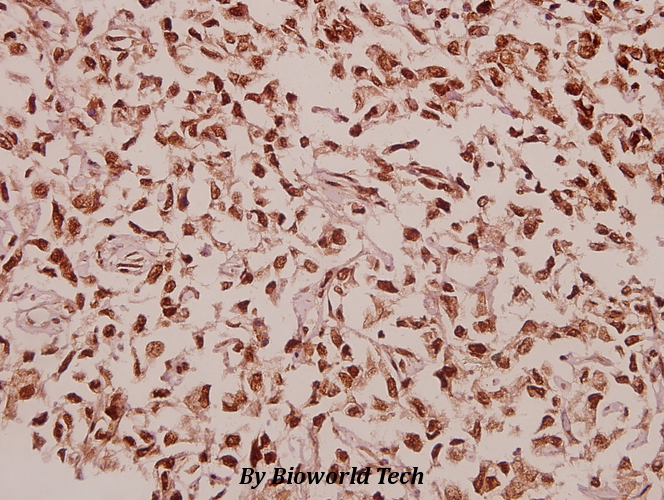Product Name :
RPL39 (S39) polyclonal antibody Background :
Ribosomes, the organelles that catalyze protein synthesis, are composed of a small subunit (40S) and a large subunit (60S) that consist of over 80 distinct ribosomal proteins. Mammalian ribosomal proteins are encoded by multigene families that contain processed pseudogenes and one functional introncontaining gene within their coding regions. Ribosomal Protein L39 (RPL39), also known as 60S Ribosomal Protein L39, consists of 51 amino acids and is the smallest protein found in liver ribosomes. Ribosomal Protein L39 localizes to cytoplasm and is a member of the S39E family of ribosomal proteins. The gene encoding Ribosomal Protein L39 maps to human chromosome Xq24, and shares 92 percent homology with Ribosomal Protein L39L (Ribosomal Protein L39-like), which is also known as RPL39L, L39-2 or RPL39L1. Ribosomal Protein L39L is associated with the 60S ribosomal subunit and is expressed in testis with localization in nucleolus. Product :
Rabbit IgG, 1mg/ml in PBS with 0.02% sodium azide, 50% glycerol, pH7.2 Storage&Stability :
Store at 4°C short term. Aliquot and store at -20°C long term. Avoid freeze-thaw cycles. Specificity :
Ribosomal Protein L39 (S39) polyclonal antibody detects endogenous levels of Ribosomal Protein L39 protein. Immunogen :
Synthetic peptide, corresponding to the N-terminal of Human Ribosomal Protein L39. Conjugate :
Unconjugated Modification :
Unmodification
RPL39 (S39) polyclonal antibody Background :
Ribosomes, the organelles that catalyze protein synthesis, are composed of a small subunit (40S) and a large subunit (60S) that consist of over 80 distinct ribosomal proteins. Mammalian ribosomal proteins are encoded by multigene families that contain processed pseudogenes and one functional introncontaining gene within their coding regions. Ribosomal Protein L39 (RPL39), also known as 60S Ribosomal Protein L39, consists of 51 amino acids and is the smallest protein found in liver ribosomes. Ribosomal Protein L39 localizes to cytoplasm and is a member of the S39E family of ribosomal proteins. The gene encoding Ribosomal Protein L39 maps to human chromosome Xq24, and shares 92 percent homology with Ribosomal Protein L39L (Ribosomal Protein L39-like), which is also known as RPL39L, L39-2 or RPL39L1. Ribosomal Protein L39L is associated with the 60S ribosomal subunit and is expressed in testis with localization in nucleolus. Product :
Rabbit IgG, 1mg/ml in PBS with 0.02% sodium azide, 50% glycerol, pH7.2 Storage&Stability :
Store at 4°C short term. Aliquot and store at -20°C long term. Avoid freeze-thaw cycles. Specificity :
Ribosomal Protein L39 (S39) polyclonal antibody detects endogenous levels of Ribosomal Protein L39 protein. Immunogen :
Synthetic peptide, corresponding to the N-terminal of Human Ribosomal Protein L39. Conjugate :
Unconjugated Modification :
Unmodification
-

-
 Immunohistochemistry (IHC) analyzes of RPL39 (S39) pAb in paraffin-embedded human colorectal carcinoma tissue at 1:50.
Immunohistochemistry (IHC) analyzes of RPL39 (S39) pAb in paraffin-embedded human colorectal carcinoma tissue at 1:50.
Bioworld Biotech only provide peptides for our antibodies and do not provide additional peptide customization services.
Price/Size :
USD 368/1mg/vial
Tips:
For phospho antibody, we provide phospho peptide(0.5mg) and non-phospho peptide(0.5mg).Describe :
Blocking peptides are peptides that bind specifically to the target antibody and block antibody binding. These peptide usually contains the epitope recognized by the antibody. Antibodies bound to the blocking peptide no longer bind to the epitope on the target protein. This mechanism is useful when non-specific binding is an issue, for example, in Western blotting (WB) and Immunohistochemistry (IHC). By comparing the staining from the blocked antibody versus the antibody alone, one can see which staining is specific; Specific binding will be absent from the western blot or IHC performed with the neutralized antibody.Formula:
Synthetic peptide was lyophilized with 100% acetonitrile and is supplied as a powder. Reconstitute with 0.1 ml DI water for a final concentration of 10 mg/ml.The purity is >90%,tested by HPLC and MS.
Storage:
The freeze-dried powder is more stable. For short time at 2-8°C. For long term storage store at -20°C.
Note :
This product is for research use only (RUO only). Not for use in diagnostic or therapeutic procedures.
 RPL39 (S39) polyclonal antibody
RPL39 (S39) polyclonal antibody  Datasheet
Datasheet COA
COA MSDS
MSDS SHIP
SHIP